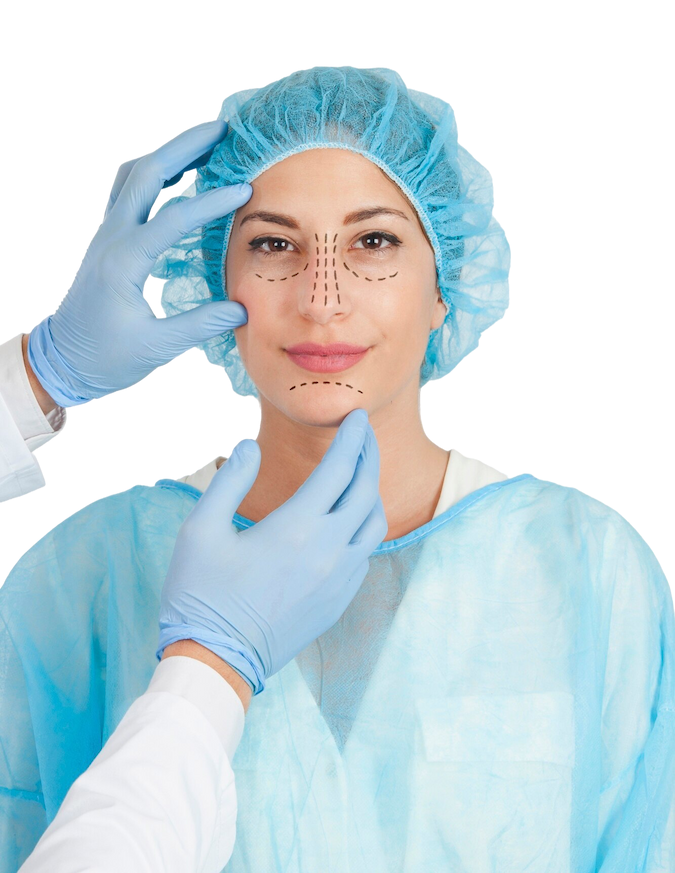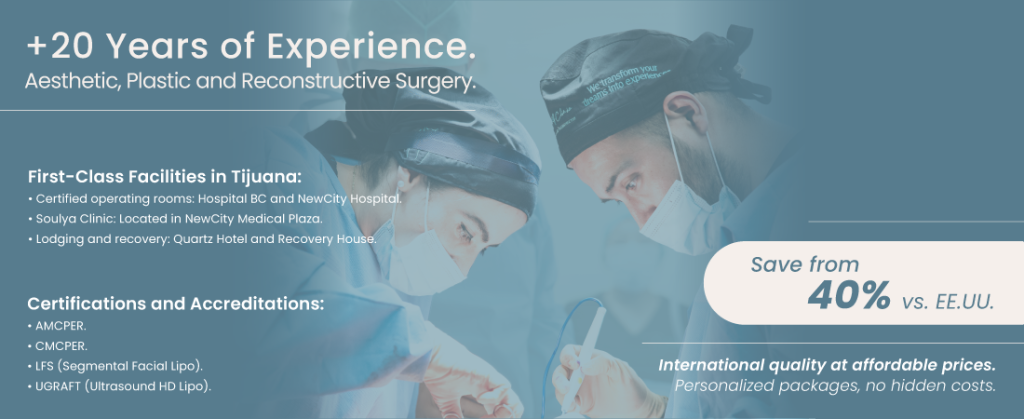Face Lift - Starting at $5,999 USD
Full Face Lift - Starting at $7,999 USD
Your package includes:
*Final face lift cost may vary based on medical evaluation and specific patient needs.



Opting for a facelift not only revitalizes your facial aesthetics but also bolsters your self-confidence, helping you feel more attractive and energetic. It’s an ideal solution for staying relevant and feeling appreciated in your social circles and on social media platforms. Let us help you continue to make a striking impression wherever you go, ensuring you look as young and lively as you feel.

This procedure is ideal if you’re noticing loose skin around your face and neck, deep lines, or a drooping jawline that no longer reflects your youthful energy, a facelift can help restore your natural contours.
Benefits of Facelifting:

We are a specialized medical team in plastic surgery in Mexico, offering solutions for aesthetic, reconstructive, and cosmetic surgery with the highest standards of quality and safety for our patients.
Our highly trained and experienced plastic surgeons, Dr. Jose Manuel Fonseca Jímenez and Dra. Laura Adriana Alvarez Correa, work with advanced technology to provide optimal and personalized results for each of our patients.
Trust us to help you achieve your beauty and wellness goals with the best plastic surgery in Mexico.

Trained at UNAM with a specialty in Plastic Surgery from the General Hospital of Mexico, Dr. Álvarez Correa is known for her personalized approach and the natural-looking results she achieves in procedures such as rhinoplasty, breast augmentation, and abdominoplasty.
Medical License: 12024033 | Certification No. 2166
Trustindex verifies that the original source of the review is Google. Es muy buena doctora, excelente atención y dando seguimiento, según sea tu caso 👍Trustindex verifies that the original source of the review is Google. Me encantó el trato a la hora de pedirle información,resuelven todas tus dudas amablemente☺️💗Trustindex verifies that the original source of the review is Google. Let me start from the beginning. Making a virtual consult . Super easy and efficient. Meeting Dr Laura via the virtual consult. She was so personable, sweet and most importantly thorough in explaining everything in regards to the procedure. Thereafter I was in contact with Amor via text message. She was efficient in answering any further questions or concerns I had. I always got a response in anything I had questions about. She consistently got back to me and let me tell you I had about 1000k questions. The day of my procedure. I opted to use their transportation and it was perfect. My driver was at the airport waiting for me and my husband. When I couldn’t find him , he was kind enough to find us. With no issues and no hesitation. Making everything easy for us. Meeting the staff at FYA CLINIC. Everyone was so hospitable. They went over everything . And it went so smoothly. Carolina was my nurse. She was Amazing and took great care of me when prepping and thereafter. Also she kept in constant contact with me after my procedure and helped me with any and all questions I had afterwards. Lorena was another nurse . And she made me feel so comfortable and was very kind while I was in surgery. The anesthesiologist, Estefany Soto. Very professional .She asked all the important questions went over eveything with me and explained everything making me feel so comfortable and most important safe. I had no pain during the procedure and she spoke to me to make sure I was comfortable during the operation. Dr Laura , I am so pleased with my results . I am so happy that I chose FYA CLINIC. I would highly recommend them. Thank you so much for fixing what I was very insecure about. You and your staff are amazing . Your sister was also so kind . I would go back to this clinic in the future for any other procedures. Also , my transportation back to the airport was ready for me as soon as I was released ! How great is that. Didn’t even have to wait!!! Such a wonderful and easy experience! FyA clinic for the win !!!!Trustindex verifies that the original source of the review is Google. Much more than I imagined, it was great experience from the first check-up to my departure from the recovery house. Every moment I was surprised by how controlled and detailed all their logistics are. And the best thing is that I had rhinoplasty and breast implant replacement and I didn't feel any pain at any time!!! That's incredible 🤩 I would really recommend them a thousand times 😍 thank you very much F and A Clinic 🤩Trustindex verifies that the original source of the review is Google. I'm so impressed with Dr. Laura and her entire staff! They were all so kind and professional! I’m so happy with the results of my breast implants and lift! Dr. Laura did exactly what i wanted!Trustindex verifies that the original source of the review is Google. What a great week I had!! From day one, a couple months ago, when I reached out to Diana, the care coordinator, the service and care has been exceptional! I came to have a mommy makeover from California. The doctors told me exactly what I needed and explained everything in detail and welcomed me into their arms the moment I walked into the office for the consult. Before surgery, the anesthesiologist was very detailed as to what she was going to be doing and that I'd be in good hands. And good hands I was because Dr. Laura and Dr. Jose are artists!! Everyone was so nice, so caring and very friendly including the care at FyA Clinic and the Amenity Recovery House. Carolina helped me in all ways including my paperwork for work. She's so sweet and keeps in touch and we update each other daily while I'm healing. Adriana, who did 3 lymphatic drainage massages was magical! Really helped with swelling. I would take this wonderful team over anyone here in the United States! And I can't forget David and Melissa who were on top of my care and transportation at Amenity Recovery. Spectacular service! Thank you so much! I can't wait to update you with my pictures! Swim Mermaids Swim!! 🧜♀️Trustindex verifies that the original source of the review is Google. Comparto mi experiencia,para recomendar y darle las gracias a los doctores..(Laura y Jose) y a todo el equipo que estuvo pendiente de mi recuperación, hacerme centir como en casa.muy profesionales y amable Tod@s.. estoy satisfecha con mis resultados..GRACIASSSS…FYA….CLINICTrustindex verifies that the original source of the review is Google. "Wow, what an exceptional experience from the team at FYA Clinic exceeded my expectations in every way. The office is sleek, modern, and spotlessly clean, and the staff is warm, welcoming, and genuinely caring. Dr. Laura Alvarez & Dr. Manuel Fonseca true artist and master of their craft -The attention to detail, the expertise, and the dedication to patient satisfaction are all top-notch. I felt completely supported and informed throughout the entire process, If you're considering plastic reconstructive surgery, look no further - this is the place to be! You'll be in the best hands possible with this incredible team. 5 stars isn't enough - I'd give them 10 stars if I could! 💫❤️" Again to my coordinator Amor thank you for being so patient with me and answering any and every question I had. Carolina thank your absolutely amazing, fya has the best bedside manners Will continue to update ❤️
What is a facelift?
A facelift, or rhytidectomy, is a surgical procedure designed to reduce visible signs of aging in the face and neck. It helps eliminate sagging skin, redefine facial contours, and smooth deep wrinkles, resulting in a more youthful and natural appearance.
What is the best age for a facelift?
Ideal candidates for a facelift are individuals in good health, typically between the ages of 40 and 70, who have noticeable signs of aging such as sagging skin, deep wrinkles, or a drooping jawline. Non-smokers with realistic expectations of the procedure tend to experience the best results.
Benefits of a Facelift
A facelift offers both physical rejuvenation and emotional empowerment. Its key benefits include:
Overall facial rejuvenation, giving you a fresher, revitalized look.
Lifting and repositioning of sagging tissues, restoring structure to the cheeks, jawline, and neck.
Restored firmness in the face and neck area.
Enhanced facial contouring, with a more sculpted appearance.
Smoothing of deep wrinkles and folds, particularly in the mid-to-lower face.
Improved appearance of excess skin and fat in the neck.
Long-lasting, natural-looking results that respect your facial identity.
Boosted confidence and self-esteem, by reflecting how youthful and vibrant you feel inside.
Feeling good about yourself, with a direct positive impact on your emotional well-being.
Things to Consider Before Surgery
What is the surgery process like?
The procedure consists of several steps:
How long does the surgery take?
Facelift surgery takes approximately 5 hours, although it can vary depending on the type of lift and the amount of correction required.
Is the facelift procedure painful?
Facelift surgery is performed under general anesthesia, so patients should not feel pain during the procedure. After the surgery, some discomfort, swelling, and bruising are common, but these can be managed with pain medications prescribed by the surgeon.
What type of anesthesia is used?
The procedure is performed under sedation, allowing the patient to remain calm, conscious, and pain-free. This is a safe and effective option that offers a more controlled recovery than general anesthesia.
What is the recovery time for a facelift?
Most patients can return to light activities within 10 to 14 days. Full recovery, including the reduction of swelling and bruising, may take several weeks. It’s important to follow post-surgery instructions for proper healing, including limiting physical activity and avoiding sun exposure.
Will the scars be visible after a facelift?
The incisions made during a facelift are strategically placed in natural creases and hidden areas, such as around the ears and hairline. As the healing process progresses, scars typically fade and become less noticeable.
How should I prepare for a facelift?
Proper preparation ensures a smooth procedure and recovery. Follow these key steps:
What are the post-operative care instructions?
Recovery after a facelift requires special attention to ensure safe healing and beautiful results. At Soulya, we guide and support you through every stage with expert care and a human touch.
Rest and Positioning
Relative rest for the first 24 hours.
Sleep on your back for at least 2 weeks.
Avoid lifting heavy objects for 6 weeks.
Compression and Sun Protection
Wear your facial compression band for 1 week (ensure it’s not too tight).
Avoid sun exposure for 2 weeks to prevent inflammation and scar pigmentation.
Hygiene
Shower daily with lukewarm water and fragrance-free neutral soap.
Do not use bathtubs or hot water.
Medication and Follow-Up
Do not take aspirin, ibuprofen, Naxen, Advil, or consume alcohol or tobacco for 3 weeks.
Your first follow-up visit will include suture removal. We will also recommend:
Scar reduction cream,
Vitamin K cream for bruising,
Optional arnica cream to help reduce swelling.
Your prescription must be filled at pharmacies in Mexico.
Facial Massages
Starting one week after surgery, you may begin gentle facial massages using a clean jade roller (ask your doctor or nurse before starting).
Physical Activity
Sexual activity may resume between weeks 3–4, if you feel ready.
Light cardio: from week 6.
Weightlifting or intense exercise: after 3 months, as tolerated.
Diet
Avoid for 3 weeks: flours, sugars, fried/processed/spicy/salty foods.
Eat: lean proteins (chicken, fish, red meat), vegetables throughout the day, and fruit in the morning (pineapple, hibiscus, apple, papaya, prunes).
Normal:
Swelling and facial bruising for the first week.
Numbness or lack of sensitivity in some areas.
Stabbing sensations the first two weeks.
General discomfort that will gradually improve.
Not Normal:
Foul-smelling, green or yellow discharge.
Fever, chills, intense pain, or heavy bleeding.
Extreme swelling or lumps in the face or neck.
Remember: Every body heals differently. At Soulya, we’re with you every step of the way to ensure a safe, supported recovery—guided by expert care and compassion.

Addresses
Copyrights © 2025 – Soulya. All rights reserved.